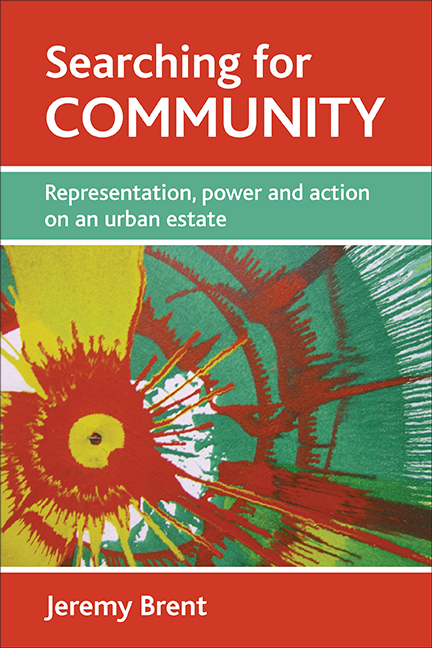Book contents
- Frontmatter
- Contents
- Foreword
- Notes on the author
- Introduction
- one Four settings: contexts and questions
- two Researching Southmead: problems of representation and participation
- three The intelligent outsider? Official and media representations of Southmead
- four Knowledge from within: community art and local representations
- five The outsider within: crossing worlds
- six Young people and community: trouble and tribes
- seven Four examples of community action in Southmead
- eight What is community anyway?
- nine Engaging with community
- ten Communicating what youth work achieves: the smile and the arch
- Author’s acknowledgements
- Epilogue: Southmead eight years on
- Afterword: Why Jeremy Brent’s work is more relevant than ever
- Bibliography
- Index
eight - What is community anyway?
Published online by Cambridge University Press: 22 January 2022
- Frontmatter
- Contents
- Foreword
- Notes on the author
- Introduction
- one Four settings: contexts and questions
- two Researching Southmead: problems of representation and participation
- three The intelligent outsider? Official and media representations of Southmead
- four Knowledge from within: community art and local representations
- five The outsider within: crossing worlds
- six Young people and community: trouble and tribes
- seven Four examples of community action in Southmead
- eight What is community anyway?
- nine Engaging with community
- ten Communicating what youth work achieves: the smile and the arch
- Author’s acknowledgements
- Epilogue: Southmead eight years on
- Afterword: Why Jeremy Brent’s work is more relevant than ever
- Bibliography
- Index
Summary
Introduction: the multiple confusions of a word
In order to tackle the major question of this book, ‘What is community?’, this chapter looks at different ways that community is theorised, in conjunction with examples and accounts of previous chapters. It takes the form of a series of complex arguments that lead to a conclusion that is open and discursive; community is not something easily encapsulated into a formula. This is the first of two concluding chapters, to be followed by a final chapter on the problems of engaging with such an open-ended concept.
A significant theme that has emerged is the many and varied uses of the word community within Southmead, uses that can either be in almost direct opposition to each other, or tackle different, if related, facets of collective life, for example, morality, territory, action, identity and control. The meaning and purpose of the word, and the actions associated with it, vary depending on who was using it, and the situation in which it is being used. To recapitulate from the start of the book, different uses of the term within just one incident were set out in the story of the bicycle theft. Different uses and contrasting estimations of community continue through the ways Southmead and its ‘community’ (or lack) are represented, in formal surveys and policy documents and through varieties of local expression. Moving in and around Southmead, while showing it as a site of powerful forces of difference, did not clearly delineate a bounded or centred entity of community in a way that would resolve the divergence between these uses and estimations. In contrast to ideas of community as a unitary harmonious social form, we have seen the conflict created by the collective behaviour of young people, and four contrasting examples of adult community action. Each of these claims to community existed in the same place and time, and while they share the same ‘community repertoire’, they use its ‘terms and metaphors’ ‘selectively and flexibly’ and differ widely. No simple picture emerges of Southmead as a discrete community, nor is there a picture of what such a community would be like if it did exist.
The multiple uses of the term community have been widely noted; the confusion surrounding the term in Southmead is far from unique.
- Type
- Chapter
- Information
- Searching for CommunityRepresentation, Power and Action on an Urban Estate, pp. 203 - 240Publisher: Bristol University PressPrint publication year: 2009



